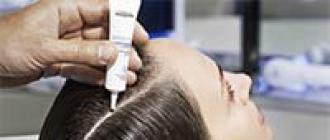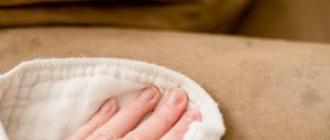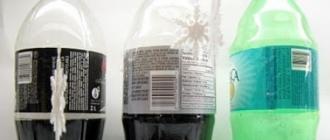Very visual is the experience with a beautiful effect of formation on the glass of a mirror coating. For this reaction, you need to stock up on experience and patience. In this article, you will learn about the necessary and specific features of equipment preparation, and also see what reaction equations this process follows.
The essence of the silver mirror reaction is the formation of metallic silver as a result of a redox reaction during the interaction of an ammonia solution of silver oxide in the presence of aldehydes.
"Silver Mirror" (test tube on the left)To create a durable silver layer you will need:
- glass flask with a capacity of up to 100 ml;
- ammonia solution (2.5-4%);
- silver nitrate (2%);
- aqueous solution of formaldehyde (40%).
Instead, you can take the ready-made Tollens reagent - an ammonia solution of silver oxide. To create it, you need to add 1 gram of silver nitrate to 10 drops of water (if the liquid will be stored for a long time, you need to place it in a dark place or in a glass container with dark walls). Immediately before the experiment, the solution (about 3 ml) must be mixed in a 1:1 ratio with a 10% aqueous solution of sodium hydroxide. Silver can precipitate, so it is diluted by slowly adding an ammonia solution. We recommend that you conduct another spectacular experiment with an ammonia solution and print a “chemical photograph”.
The reaction is carried out at room temperature. A prerequisite for a successful final is perfectly clean and smooth walls of a glass vessel. If there are the smallest particles of pollution on the walls, the sediment resulting from the experiment will become a loose layer of black or dark gray.
To clean the flask, use different types alkali solutions. So, for processing, you can take a solution that, after cleaning, has to be washed off with distilled water. It is necessary to rinse the flask from the cleaning agent many times.
Why is cleanliness so important?
The fact is that the colloidal silver particles formed at the end of the experiment must firmly adhere to the glass surface. On its surface there should be no fats and mechanical particles. water does not contain salts and is ideal for the final cleaning of the flask. It can be prepared at home, but it is easier to buy ready-made liquid.
Silver mirror reaction equation:
Ag₂O + 4 NH₃ H₂O ⇄ 2OH + 3H₂O,
where OH is diammine silver hydroxide, obtained by dissolving the metal oxide in an aqueous solution of ammonia.
 Diamminesilver complex molecule
Diamminesilver complex molecule
Important! The reaction works at low concentrations of ammonia - carefully observe the proportions!
This is how the final stage of the reaction proceeds:
R (any aldehyde)-CH=O + 2OH → 2Ag (precipitated silver colloid) ↓ + R-COONH₄ + 3NH₃ + H₂O
The second step of the reaction is best carried out by carefully heating the flask over a burner flame - this will increase the chances that the experiment will be successful.
What can a silver mirror reaction show?
This interesting chemical reaction demonstrates not only certain states of matter - it can be used to perform a qualitative determination of aldehydes. That is, such a reaction will solve the question: is there an aldehyde group in the solution or not.
 General structural formula of aldehydes
General structural formula of aldehydes
For example, in a similar process, you can find out what is contained in the solution: glucose or fructose. Glucose will give a positive result - you will get a “silver mirror”, and fructose contains a ketone group and you cannot get a silver precipitate. In order to carry out the analysis, instead of a formaldehyde solution, it is necessary to add a 10% glucose solution. Consider why and how dissolved silver turns into a solid precipitate:
2OH + 3H₂O + C₆H₁₂O₆ (glucose) = 2Ag↓+ 4NH₃∙H₂O + C₆H₁₂O₇ (gluconic acid is formed).
Lab #5
Propertiescarbohydrates
Experiment 1. Silver mirror reaction is a recovery reaction silver from ammonia solution silver oxide (Tollens reagent).
in aqueous solution ammonia silver oxide dissolves to form a complex compound - diamminesilver(I) hydroxide OH
when added to which aldehyde a redox reaction occurs with the formation of metallic silver:
If the reaction is carried out in a vessel with clean and smooth walls, then silver precipitates in the form of a thin film, forming a mirror surface.
In the presence of the slightest contamination, silver is released in the form of a gray loose precipitate.
The silver mirror reaction can be used as a qualitative test for aldehydes. Thus, the reaction of the "silver mirror" can be used as a distinguishing between glucose and fructose. Glucose belongs to aldoses (containing an open aldehyde group), and fructose belongs to ketoses (containing an open keto group). Therefore, glucose gives a "silver mirror" reaction, while fructose does not. But if an alkaline medium is present in the solution, then ketoses isomerize into aldoses and also give positive reactions with an ammonia solution silver oxide (Tollens reagent).
Qualitative reaction of glucose with ammonia solution of silver oxide. You can prove the presence of an aldehyde group in glucose using an ammonia solution of silver oxide. Add a glucose solution to the ammonia solution of silver oxide and heat the mixture in a water bath. Soon, metallic silver begins to deposit on the walls of the flask. This reaction is called the silver mirror reaction. It is used as a quality for the discovery of aldehydes. The aldehyde group of glucose is oxidized to a carboxyl group. Glucose is converted to gluconic acid.
CH 2 OH - (CHOH) 4 – SLEEP+Ag 2 O= CH 2 OH - (CHOH) 4 – COOH + 2Ag↓

The order of the work.
Pour 2 ml into two test tubes. ammonia solution of silver oxide. 2 ml is added to one of them. 1% glucose solution, in another - fructose. Both tubes are boiling.
An ammonia solution of silver hydroxide is obtained by reacting silver nitrate with sodium hydroxide and ammonium hydroxide:
AgNO3+ NaOH → AgOH↓+ NaNO3,
AgOH + 2 NH4 OH→[Ag(NH3)2] OH + H2O,
ammonia solution
OH + 3 H2 → Ag2O + 4 NH4 OH.
The principle of the method. A mirror is formed on the walls of the test tube with glucose as a result of the release of metallic silver.
Work design: Write the conclusion, as well as the course and equations of the reaction in a notebook.
Experience 3. Qualitative reaction to fructose
The principle of the method. When a sample with fructose is heated in the presence of resorcinol and of hydrochloric acid up to 80 ° C after a while a bright red color appears in a test tube with fructose.
When a sample with fructose is heated in the presence of resorcinol and of hydrochloric acid a cherry red color appears. The assay is also applicable to the detection of other ketosis. Aldoses under the same conditions, they interact more slowly and give a pale pink color or do not interact at all. open F. F. Selivanov in 1887. It is used in the analysis of urine. The test is positive for fructosuria of metabolic or transport origin. In 13% of cases, the test is positive with a food load of fruits and honey. Chem. formula fructose - C 6 H 12 O 6

The cyclic formula of fructose
Acyclic form 
fructose
Painted connection
R-residue
hydroxymethylfurfural
The order of the work.
2 ml are poured into two test tubes: in one - 1% glucose solution, in the other - 1% fructose solution. Both tubes are filled with 2 ml of Selivanov's reagent: 0.05 g of resorcinol is dissolved in 100 ml of 20% hydrochloric acid. Both tubes are gently heated to 80°C (before boiling). A red color appears.

Conclusions: the results of the experiment and the reaction equation are written in a notebook.
Very visual is the experience with a beautiful effect of formation on the glass of a mirror coating. For this reaction, you need to stock up on experience and patience. In this article, you will learn about the necessary and specific features of equipment preparation, and also see what reaction equations this process follows.
The essence of the silver mirror reaction is the formation of metallic silver as a result of a redox reaction during the interaction of an ammonia solution of silver oxide in the presence of aldehydes.
"Silver Mirror" (test tube on the left)To create a durable silver layer you will need:
- glass flask with a capacity of up to 100 ml;
- ammonia solution (2.5-4%);
- silver nitrate (2%);
- aqueous solution of formaldehyde (40%).
Instead, you can take the ready-made Tollens reagent - an ammonia solution of silver oxide. To create it, you need to add 1 gram of silver nitrate to 10 drops of water (if the liquid will be stored for a long time, you need to place it in a dark place or in a glass container with dark walls). Immediately before the experiment, the solution (about 3 ml) must be mixed in a 1:1 ratio with a 10% aqueous solution of sodium hydroxide. Silver can precipitate, so it is diluted by slowly adding an ammonia solution. We recommend that you conduct another spectacular experiment with an ammonia solution and print a “chemical photograph”.
The reaction is carried out at room temperature. A prerequisite for a successful final is perfectly clean and smooth walls of a glass vessel. If there are the smallest particles of pollution on the walls, the sediment resulting from the experiment will become a loose layer of black or dark gray.
To clean the flask, you need to use different types of alkali solutions. So, for processing, you can take a solution that, after cleaning, has to be washed off with distilled water. It is necessary to rinse the flask from the cleaning agent many times.
Why is cleanliness so important?
The fact is that the colloidal silver particles formed at the end of the experiment must firmly adhere to the glass surface. On its surface there should be no fats and mechanical particles. water does not contain salts and is ideal for the final cleaning of the flask. It can be prepared at home, but it is easier to buy ready-made liquid.
Silver mirror reaction equation:
Ag₂O + 4 NH₃ H₂O ⇄ 2OH + 3H₂O,
where OH is diammine silver hydroxide, obtained by dissolving the metal oxide in an aqueous solution of ammonia.
 Diamminesilver complex molecule
Diamminesilver complex molecule
Important! The reaction works at low concentrations of ammonia - carefully observe the proportions!
This is how the final stage of the reaction proceeds:
R (any aldehyde)-CH=O + 2OH → 2Ag (precipitated silver colloid) ↓ + R-COONH₄ + 3NH₃ + H₂O
The second step of the reaction is best carried out by carefully heating the flask over a burner flame - this will increase the chances that the experiment will be successful.
What can a silver mirror reaction show?
This interesting chemical reaction demonstrates not only certain states of matter - it can be used to perform a qualitative determination of aldehydes. That is, such a reaction will solve the question: is there an aldehyde group in the solution or not.
 General structural formula of aldehydes
General structural formula of aldehydes
For example, in a similar process, you can find out what is contained in the solution: glucose or fructose. Glucose will give a positive result - you will get a “silver mirror”, and fructose contains a ketone group and you cannot get a silver precipitate. In order to carry out the analysis, instead of a formaldehyde solution, it is necessary to add a 10% glucose solution. Consider why and how dissolved silver turns into a solid precipitate:
2OH + 3H₂O + C₆H₁₂O₆ (glucose) = 2Ag↓+ 4NH₃∙H₂O + C₆H₁₂O₇ (gluconic acid is formed).
Completing of the work:
1 ml of formalin was poured into a test tube and a little ammonia solution of silver oxide was added. The test tube was heated. Observe the deposition of silver on the walls and bottom of the tube. The surface of the glass becomes reflective, because this is the principle of making mirrors.
Experience 2. Oxidation of benzaldehyde with atmospheric oxygen
Completing of the work:
A drop of benzaldehyde was placed on a glass slide and left in air for 30 min. We observe the formation of white crystals along the edges of the drop. An oxidation reaction took place, producing benzoic acid.

Experience 3. Obtaining acetone from sodium acetate
A little bit of sodium acetate powder was placed in a test tube and closed with a cork with a gas outlet tube. The test tube was fixed on a tripod. End gas tube dropped into a test tube filled with water. A test tube with sodium acetate was heated. We observe the release of gas bubbles in a test tube with water and a specific smell of acetone is felt. After the reaction stops, add one drop of concentrated hydrochloric acid to the first test tube. Observe the release of bubbles of carbon dioxide.
To begin with, each class of organic substances has a certain reaction by which its representatives can be distinguished from other substances. The school chemistry course assumes the study of all qualitative reagents for the main classes of organic substances.
Aldehydes: structural features
Representatives of this class are derivatives of saturated hydrocarbons in which the radical is connected to the aldehyde group. The isomers of aldehydes are ketones. Their similarity lies in belonging to the class of carbonyl compounds. When performing a task that involves isolating aldehyde in a mixture, a “silver mirror” reaction will be required. Let us analyze the features of this chemical transformation, as well as the conditions for its implementation. The silver mirror reaction is a process of reduction from silver diamine (1) hydroxide to metallic silver. In a simplified form, this complex compound can be written in a simplified form of silver oxide (1).
Separation of carbonyl compounds
To form a complex compound, silver oxide is dissolved in ammonia. Given that the process is a reversible reaction, the silver mirror reaction is performed with a freshly prepared ammonia solution of silver oxide (1). When a complex compound of argentum is mixed with an aldehyde, a redox reaction occurs. The completion of the process is indicated by the precipitation of metallic silver. With the correct implementation of the interaction of ethanal and the ammonia solution of silver oxide, the formation of a silver coating is observed on the walls of the test tube. It was the visual effect that gave this interaction the name of the "silver mirror".

Definition of carbohydrates
The silver mirror reaction is qualitative for an aldehyde group, which is why it is also mentioned in organic chemistry courses as a way to recognize carbohydrates such as glucose. Given the specifics of the structure of this substance, which exhibits the properties of an aldehyde alcohol, thanks to the “silver mirror” reaction, glucose can be distinguished from fructose. Thus, this is not only a qualitative reaction to aldehydes, but also a way to recognize many other classes of organic substances.

Practical application of the "silver mirror"
It would seem, what difficulties can arise with the interaction of aldehydes and an ammonia solution of silver oxide? You just need to purchase silver oxide, stock up on ammonia and pick up aldehyde - and you can safely proceed to the experiment. But such a primitive approach will not lead the researcher to the desired result. Instead of the expected mirror surface on the walls of the test tube, you will see (in best case) dark brown silver suspension.

The essence of interaction
A qualitative reaction to silver implies compliance with a certain algorithm of actions. Often, even when signs of a mirror layer appear, its quality clearly leaves much to be desired. What are the reasons for this failure? Is it possible to avoid them? Among the many problems that can lead to an undesirable result, there are two main ones:
- violation of the conditions for conducting chemical interaction;
- poor quality surface preparation for silvering.
During the interaction of the initial substances in solution, silver cations are formed, which combine with the aldehyde group, resulting in the formation of colloidal fine silver particles. These grains are capable of adhering to glass, but may remain in solution as a silver suspension. In order for the precious metal particles to adhere to the glass, to form a uniform and durable layer, it is important to pre-degrease the glass. Only in the presence of an ideally clean initial surface of the test tube can one count on the formation of a uniform silver layer.
Possible problems
The main contaminant of glassware is greasy coating, which must be disposed of. An alkali solution will help solve the problem, as well as a hot chromium mixture. Next, the tube is washed with distilled water. In the absence of alkali, you can use a synthetic dishwashing detergent. After degreasing is completed, the glass is washed with a solution of tin chloride, rinsed with water. Distilled water is used to prepare solutions. In case of its absence, you can use rainwater. Glucose and formaldehyde are used as reducing agents that allow a pure substance to precipitate from a solution. With aldehyde, it is difficult to count on obtaining a high-quality silver coating, but the monosaccharide (glucose) gives a uniform and durable silver layer on the surface of the mirror.

Conclusion
To silver glass, it is desirable to use silver nitrate. Alkali and ammonia solution are added to this salt solution. The condition for a full-fledged reaction and silver deposition on glass is the creation of an alkaline environment. But with an excess of this reagent, side effects. Depending on the chosen method of conducting the experiment, a qualitative reaction is obtained by heating. Coloring solution in Brown color indicates the formation of the smallest colloidal particles of silver. Further, a mirror coating appears on the surface of the glass. In case of successful completion of the process, the metal layer will be even and durable.






